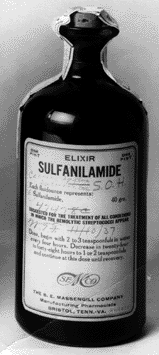Food, Drug, and Cosmetic Act
From Rx-wiki
Because of the shortcomings of the 1906 Act, the FDA petitioned Congress for a new act. Between 1933 and 1937, a legislative battle ensued to replace the 1906 law. On one side of the battle were capitalists calling for laissez faire, on the other were social reformers fighting for government intervention due to concerns over public safety. Ultimately, it was a therapeutic disaster in 1937 that motivated Congress to act. A Tennessee company marketed a sulfa drug in an untested solvent (diethylene glycol) that resulted in the death of 107 people, many of whom were children. The public outcry not only reshaped the drug provisions of the new law to prevent such an event from happening again, but it propelled the bill through Congress.
After being passed by both houses of Congress it was signed into law by President Franklin D. Roosevelt on June 25, 1938
The Federal Food, Drug, and Cosmetic Act contains the following new provisions:
- Extending control to cosmetics and therapeutic devices.
- Requiring new drugs to be shown safe before marketing-starting a new system of drug regulation.
- Eliminating the Shirley Amendment requirement to prove intent to defraud in drug misbranding cases.
- Providing that safe tolerances be set for unavoidable poisonous substances.
- Authorizing standards of identity, quality, and fill-of-container for foods.
- Authorizing factory inspections.
- Adding the remedy of court injunctions to the previous penalties of seizures and prosecutions.
This particular act is still the basis of the Food and Drug Administration's authority although it has received various amendments in the past 75 years. The major amendments include:
- Durham-Humphrey Amendment
- Kefauver Harris Amendment
- Medical Device Amendment
- Orphan Drug Act
- Drug Price Competition and Patent Term Restoration Act
- Prescription Drug Marketing Act
- Dietary Supplements and Health Education Act
- Food and Drug Administration Modernization Act
- Best Pharmaceuticals for Children Act
See also
Federal pharmacy law
Durham-Humphrey Amendment
Kefauver Harris Amendment
Medical Device Amendment
Orphan Drug Act
Drug Price Competition and Patent Term Restoration Act
Prescription Drug Marketing Act
Dietary Supplements and Health Education Act
Food and Drug Administration Modernization Act
Best Pharmaceuticals for Children Act
Food and Drug Administration
References
- Pharmacy Times, A Review of Federal Legislation Affecting Pharmacy Practice, Virgil Van Dusen , RPh, JD and Alan R. Spies , RPh, MBA, JD, PhD, https://secure.pharmacytimes.com/lessons/200612-01.asp
- Strauss's Federal Drug Laws and Examination Review, Fifth Edition (revised), Steven Strauss, CRC Press, 2000
- Food and Drug Administration, Legislation, http://www.fda.gov/RegulatoryInformation/Legislation/default.htm
- Food and Drug Administration, History, http://www.fda.gov/AboutFDA/WhatWeDo/History/default.htm
